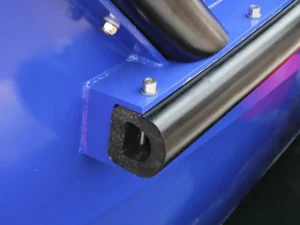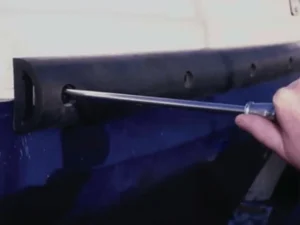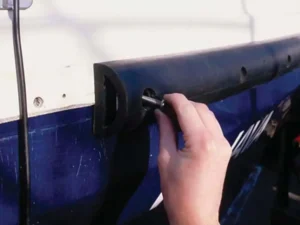Introduction
Rubber fenders are game-changers of the marine industry. From berthing to ship-to-ship transport, they are extremely helpful. Reduce the risks of damages. And keep your ships unassailable for extended periods. What if your fenders get damaged and irreparable in a collision? Always replace it with a new one to get the optimal performance you expect from a marine fender. But how do you install rubber fenders? Are there any special tools you need? In this guide, we will walk you through the whole installation scenarios of the marine fenders.
When do you need to replace the marine fender?

If you haven’t installed the Yokohama Fender on your ships, it can be the right time. Sometimes, you already have the rubber fenders installed, but you must replace them.
So, is it the right time to replace the Yokohama fenders? Let’s find out different signs for Pneumatic Fender replacement.
-
Decreased performance
It does not always happen, as a decrease in performance takes years. You need to understand the collision force absorption by the pneumatic fender has decreased significantly.
If there is a quick deterioration in performance, take it seriously before it is late or incidents occur. You can replace your fenders effectively and be on the safe side.
-
Lifespan passed
A rubber fender doesn’t have an infinite loop in its aging. Instead, it starts falling apart within 15 to 20 years. Some manufacturers have a warranty period.
If 20 years have passed and you notice a decrease in the performance of a pneumatic fender, you better discard it. And install a new one that keeps you safe.
-
Irreparable damages
When two ships collide, rubber fenders act as a first line of defense. The rubber fenders absorb all the collision energy.
So, does not anything happen to the rubber fenders in this case? Yes, surely. They sometimes get damaged. If the damage is irreparable, you should consider replacing it with a new one that performs better.
Tools and Materials on the Checklist of Rubber Fender Installation

Various tools are crucial to installing a pneumatic fender on the ship. Such tools might include measurement tapes, safe equipment, and materials for the perfect installation.
Here are different tools you should have on your checklist.
-
Measuring Tape
A measuring tape helps measure the length of the D-type fender. Moreover, by measuring the distance or height, you can position the marine fenders in a perfect location on a ship.
-
Drill bits and drill
A drill is a tool you can’t miss when installing the marine fender. It helps create the holes on your boat where you will attach your rubber fenders. At the same time, drill bits will act like bonding tools that hold the rubber fenders and ship.
-
Brush
When drilling holes, you must not leave any residues or debris. Stiff bristles help remove the residues and make the surface clean enough to put the glue and create Bonds.
-
Air Compressor
An air compressor is hit by the time when you are cleaning the hole. You must use it in the hole to get the unnecessary dust and air out. Use it until there is no dust left.
-
Acetone
Acetone is another material for cleaning drilled holes. The best thing about it is the perfect cleaning. When you pour the acetone into the drilled holes, it immediately eradicates the contaminants and makes the surface clean and better for the adhesive materials.
-
Screwdrivers
Screwdrivers tighten the screws in place and help in better bonding. You must have it in your material checklist to iron out the complexity of the process.
-
Adhesive materials like Glue
Do you know why you need the adhesive material? It helps join the screw within the hole. Adhesive materials largely depend on the type of marine fenders you have. When buying glue, check its longevity, type, and suitability for your marine fenders.
Step by Step guide on installation of rubber fenders

Perfect installation saves the day. You’ll avoid future damages and get optimal performance from your marine fenders. The opposite occurs if you do not pay attention to the installation process.
Here are seven ideal steps to install a Yokohama Fender.
-
Step 1: Measure the dimensions
Marine fenders have specific dimensions according to the length, width, and thickness. In the installation process, you must drill holes in the marine fenders.
Below the D-type fenders, you must fix the plate that avoids damage and processes the whole work faster. Therefore, measurements are necessary to know and fit the processing plates.
-
Step 2: Drilling
It is time to drill the holes in the D-type fenders. You must have the necessary tools and protective equipment. These can be:
- Electric drill
- Sealant gun
- Screwdriver
- Mask
- Gloves
Now, decide on the project specifications and move accordingly. For example, use a drill pipe that fits the length of the drilling. Know the gaps at which you are going to drill the hole. To avoid the on-time hassles, make a proper drilling earlier and buy a fender with specified features.
When drilling the hole, make sure the hole is dry. Otherwise, use artificial drying methods for the best experience.
-
Step 3: Using the Air Compressor And Brush
Air compressors can be the primary tool for cleaning. With high air pressure, all the specks of dust will blow out of the small spaces and pores in the hole. You’ll get a clean hole.
Sometimes, there is still dust inside the hole. To remove, you must get help from the rounded brushes with bristles that go in the corners where it is difficult to remove the dust.
-
Step 4: Use Acetone For Better Cleaning
Now, you can wet your brush in the acetone solvent and start applying it along the walls of the holes. It will remove the contamination and provide an effective surface to add the adhesive material.
Acetone is highly volatile and will evaporate within seconds. Once the surface is clean and dry, cover it with paper. It will keep the dust away and save you from cleaning it again.
-
Step 5: Adjust Glue
At this point, you must have two things in your hand. The first is the adhesive glue, and the second is the curing adjustment to create the polymers and provide better adhesion features.
First of all, measure the glue you need. It depends on the construction, temperature, and hole depth. Once you have the right quantity of glue, add it to the construction. Now, slowly add the curing agents for better results. Within 40 minutes, all glue usually gets used.
-
Step 6: Inject Glue in Hole
It is time to inject the glue into the hole. Check whether the hole is dry and effective for the glue injection. Also, clean it again if you find any dust materials in it.
Now, you can inject the glue into the hole until 80% of the volume is filled.
-
Step 7: Insert the Screw
After the glue is there, don’t wait for drying, as it will lose its adhesive performance. Insert the screw without wasting much time and turn it to fix it in place. Remove the air if there is any.
Put a heavy object on the screw rod to create the temporary pressure for the better adhesion in the place. After some time, the screw will get fixed and build a stronger bond. That is what you have to do!
Tips for Yokohama Fender installation
You can’t jump directly into the installation process without knowing you have all the tools and relevant dimensions. Here are some tips to follow before the final installation of the marine fenders.
-
Buying suitable marine fenders.
First of all, take a look at all types of fenders available out there. If you have decided about the rubber, assume its technical features. And make sure they meet your required demands for the installation.
-
Checking whether it fits.
Before installing, check the shape, size, and materials like nuts and bolts. Do they meet the specific demands? Can you install it now? If there is no problem, you can move to the installation.
-
Things to know during installation.
When you have installed the marine fenders, check the connection between the fender and the wharf. A tight bond is necessary. If the exposed iron surface is getting rusty, you should take extra measures to remove the rust. Sometimes, it is better to apply the anti-rust paint that keeps the rust miles away.
Endnote
Whenever you are replacing ship-launching airbags, always consider factors like:
- Quality
- Construction
- Material
- Cost
- Warranties
An ideal manufacturer offers all options in the above-par range. Do you know such a supplier? If not, don’t fret. We have Jerry Borg Marine with years of experience in the fender industry. We produce only the top-notch fenders. No compromise on quality and warranties of years keep you relaxed. Find out what we have special for you.
